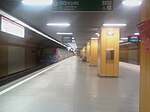Operation Reunion
Aerial operations and battles of World War IIBattles and operations of World War II involving RomaniaRomania–United States relationsWorld War II aerial operations and battles of the Eastern Front

Operation Reunion was a USAAF military operation aimed at repatriating Allied prisoners of war from Romania after the latter's change of sides in 1944. The operation was preceded by Operation Gunn, named after Lieutenant Colonel (Lt. Col.) James A. Gunn, which had the objective of establishing the connection between Bucharest and the 15th Air Force command from Bari. During the operation, more than 1,000 American, British, Dutch, and French prisoners were airlifted to Italy.
Excerpt from the Wikipedia article Operation Reunion (License: CC BY-SA 3.0, Authors, Images).Operation Reunion
Strada Indrustriei,
Geographical coordinates (GPS) Address Nearby Places Show on map
Geographical coordinates (GPS)
| Latitude | Longitude |
|---|---|
| N 44.370833333333 ° | E 26.194166666667 ° |
Address
Strada Indrustriei
Strada Indrustriei
032368 , Danubiana
Romania
Open on Google Maps










